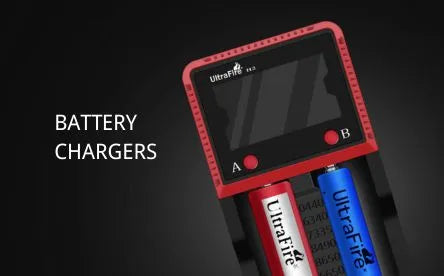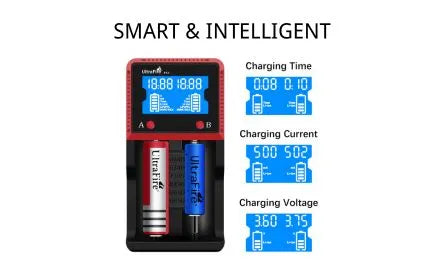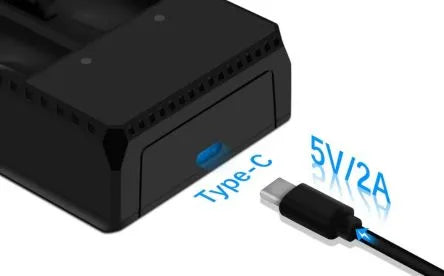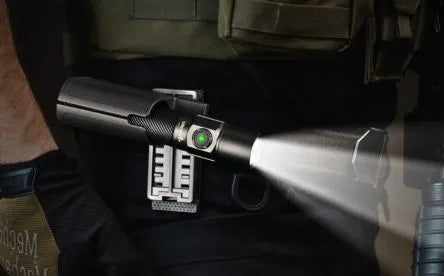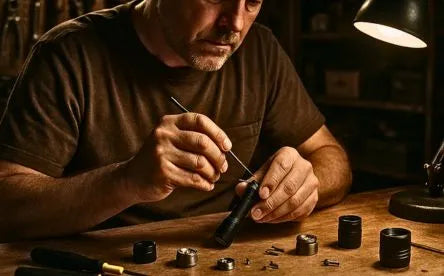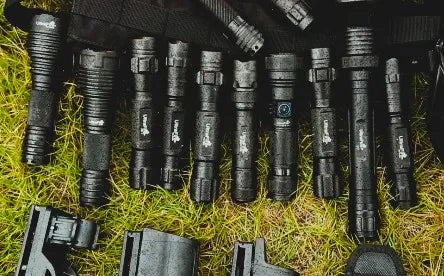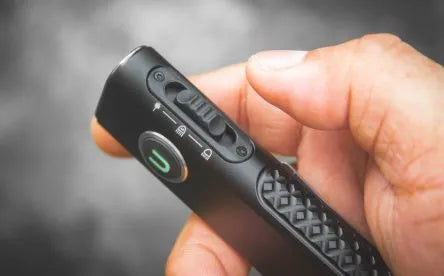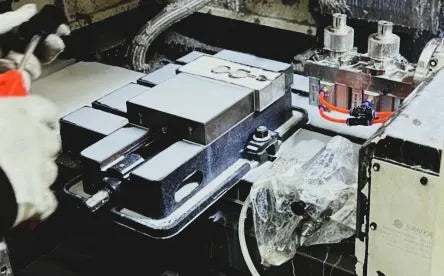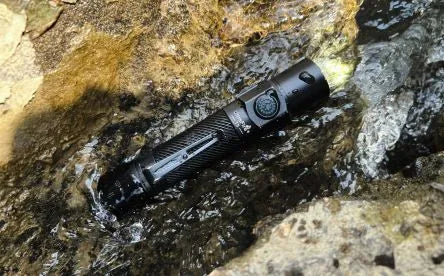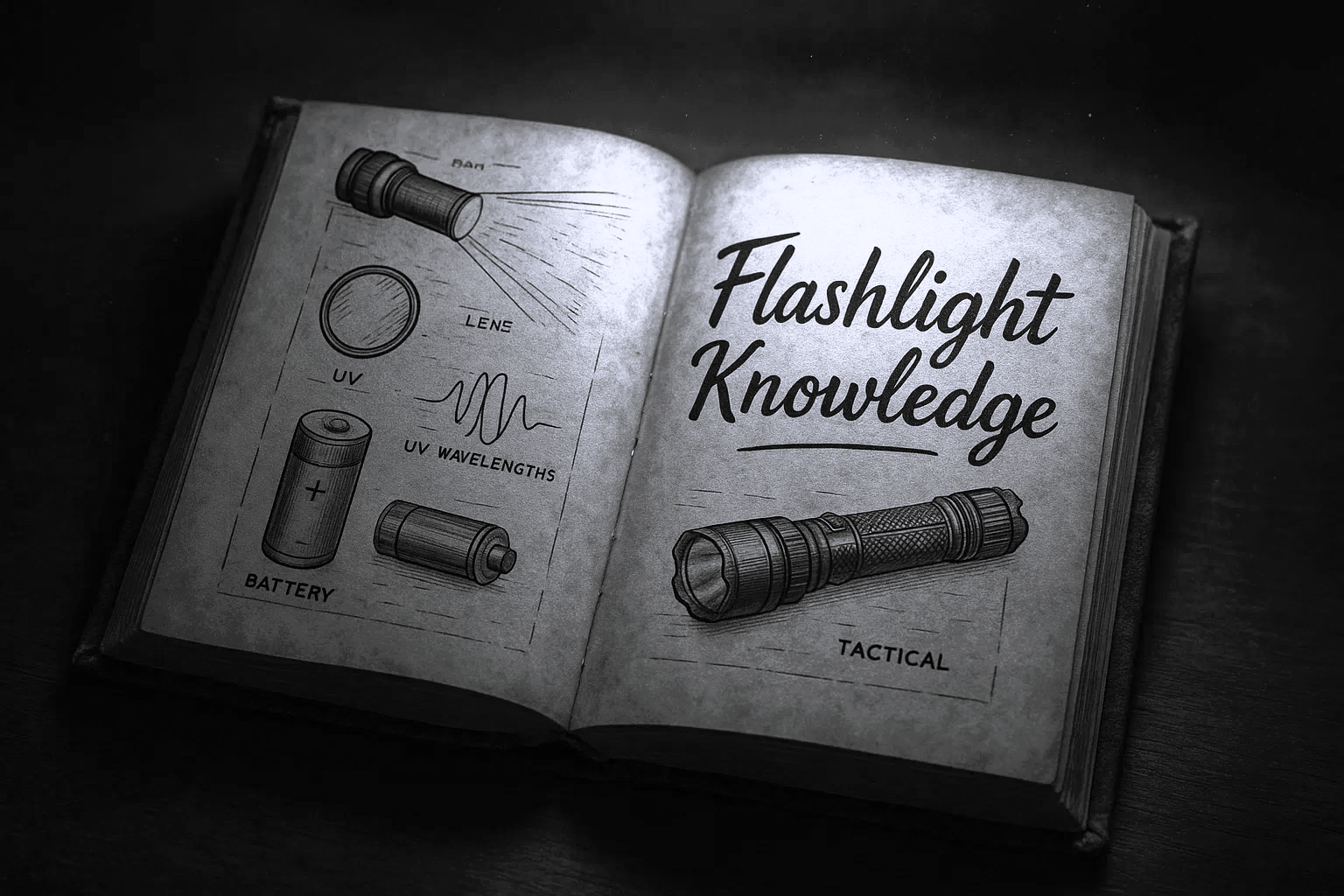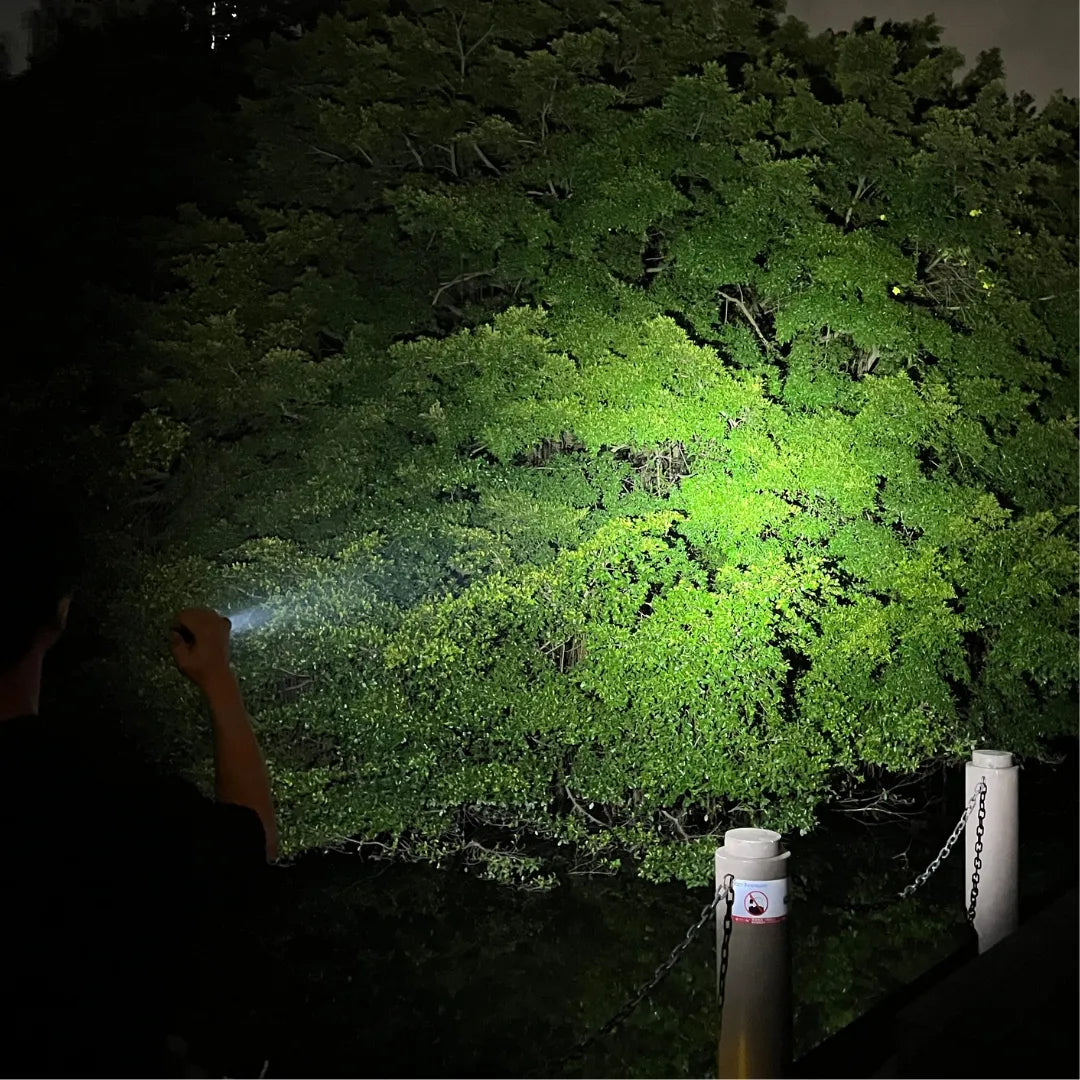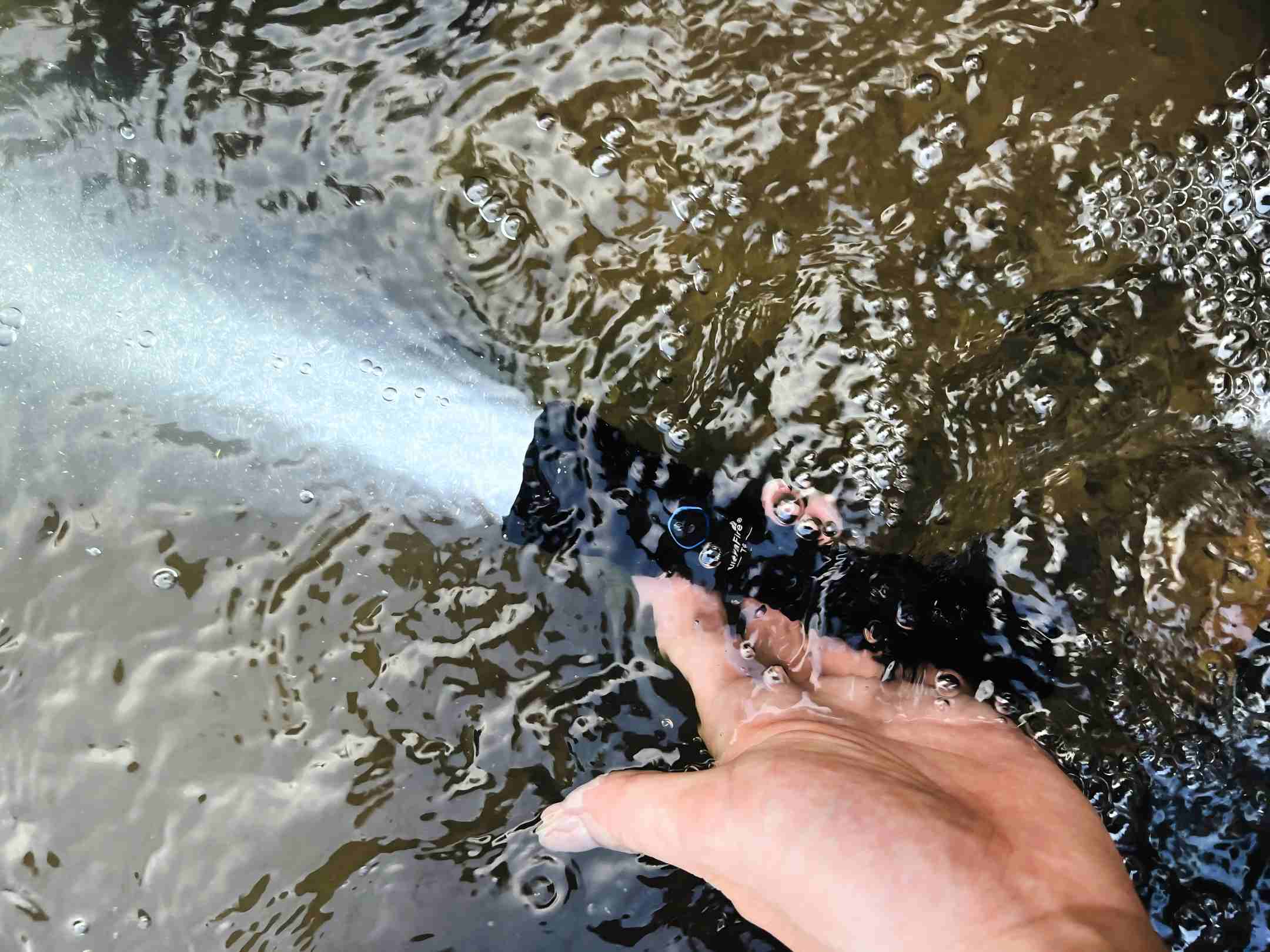1) Orange Peel Reflector (OP) — the soft, friendly beam
What it is:
An OP reflector has a textured inner surface — tiny bumps that look like the skin of an orange. That texture scatters light slightly as it reflects, smoothing out harsh edges.
How it behaves:
-
Produces a soft hotspot with a gentle transition into spill.
-
Less pronounced artifacts (rings, donuts) than a smooth reflector.
-
Spill light is usable and pleasant for close work.
Pros
-
Smooth, natural-looking beam transitions.
-
Excellent for close-to-medium range tasks.
-
Less visible LED imperfections (no “donut” or harsh ring).
Cons
-
Not as tight or far-reaching as a smooth reflector.
-
Slightly less candela (intensity) for long-range spotting.
Best for:
Camping, campsite chores, repairs under the hood, reading maps, and everyday carry when you want usable flood and a comfortable beam for people around you.
2) Smooth Reflector (SMO) — the long-range thrower
What it is:
A glassy-smooth, mirror-like reflector that reflects light with minimal scatter. Think of a classic parabolic reflector.
How it behaves:
-
Produces a very focused hotspot with bright center intensity.
-
Beam has a hard edge between hotspot and spill (unless paired with specific LED/optics).
-
Maximizes throw (candela), so it lights things farther away.
Pros
-
Best choice for distance and search tasks.
-
Higher candela for spotting and long-range observation.
-
Less energy lost to scatter; efficient for throw.
Cons
-
Harder-edged beam; spill is limited and less pleasant for close work.
-
Pronounced ring artifacts or “donut” effects if the LED or reflector alignment isn’t perfect.
Best for:
Hunting, search & rescue, tactical use, and anyone who prioritizes throw over close-range comfort.
3) TIR Lens (Total Internal Reflection) — compact power, modern versatility
What it is:
A single-piece optical lens — usually plastic — designed to direct light via total internal reflection and refraction. TIR optics combine reflector and lens functions in one element.
How it behaves:
-
Produces a very even beam with minimal artifacts.
-
Can be engineered for flood, throw, or hybrid beams by changing internal geometry.
-
Common in compact EDC lights and high-end small-head designs.
Pros
-
Compact and efficient — great for small flashlights.
-
Very even beam with smooth hotspot-to-spill transition.
-
Customizable beam shapes without a large reflector.
Cons
-
Higher cost and manufacturing precision required.
-
Plastic TIRs can yellow or be damaged by UV or heat in cheap materials.
-
If scratched, the beam may be affected noticeably.
Best for:
Small EDC lights, headlamps, and compact tactical lights where you want good beam control in a tiny package.
4) Other Common Lens Types — when you need special features
Aspherical (Convex) / Zoom Lenses
What: Moveable convex lens that slides in/out to change beam from flood to spot.
Use case: Zoomable lights (handy for multipurpose use).
Tradeoff: Zoom mechanisms add mechanical complexity and can reduce optical purity; not always as efficient as purpose-built reflectors.
AR-coated Glass
What: Glass lens with anti-reflective coating.
Use case: High-output lights and those aiming to minimize front-surface reflection loss.
Tradeoff: More expensive but increases overall transmission and reduces ghosting.
PC / Acrylic Lenses
What: Lightweight plastic lenses — tough and inexpensive.
Use case: Rugged, everyday outdoor lights.
Tradeoff: Lower transmission than glass; can scratch more easily.
Tempered Glass
What: Durable glass lens, often used on higher-end units.
Use case: Tactical/outdoor lights needing scratch and heat resistance.
Tradeoff: Heavier and a bit more fragile on impact than polycarbonate, but better optical clarity.
How optics interact with the LED and driver — why a lens isn’t everything
Two flashlights with the same reflector and different LEDs can behave very differently. A few technical notes that matter:
-
LED emitter size & position: If the LED emitter is off-center or too big for the optic, you’ll see rings, skewed hotspots, or poor focus. That’s why good manufacturers center and match LEDs to optics.
-
Tint & color temperature: The optic doesn’t change color temperature much, but the perceived beam quality can vary with tint. Cooler tints can look harsher; warmer tints softer.
-
Driver behavior: Output consistency and PWM (pulse-width modulation) at low modes can affect how smooth the beam appears — even with a great optic.
Real-world examples — choose by use case
-
Camping & tasks around camp: OP reflector or TIR — soft spill and usable hotspot make cooking, reading, and tent work easier.
-
Hiking at night / trail illumination: OP for trail work; SMO or TIR if you want to spot farther ahead.
-
Hunting / long-range spotting: SMO reflector for max throw.
-
EDC & urban use: TIR lens for compact form factor with friendly beam.
-
Search & rescue / tactical: SMO (for the throw) or high-grade TIR tailored for hybrid beams.
Buying checklist — what to look for in the specs
-
Manufacturer lists both lumens and candela/throw. Lumens tell total output; candela tells concentration and throw.
-
Look for beam photos — they show real beam profile (spot vs spill, artifacts).
-
Check emitter & optic match — if a brand lists a quality LED (e.g., a Cree emitter) and a matched optic, you’re less likely to get rings.
-
Ask about lens material — tempered glass or AR-coated glass for high output; PC/TIR for compactness.
-
Warranty & replaceability — optics can scratch or chip; check if replacements are available.
Maintenance & care — keep your beam honest
-
Clean the lens regularly with a microfiber cloth — fingerprints and grime scatter light.
-
Avoid abrasive cleaners on coated glass or plastic TIRs.
-
Replace scratched optics if beam quality drops — a tiny scratch can create flare or visible artifacts.
-
Check emitter alignment if your beam looks weird — sometimes the LED board shifts in a fall.
Quick FAQ
Q: Can I tell beam quality from lumens alone?
A: No. Lumens is total light; beam type (OP vs SMO vs TIR) and candela determine how that light is distributed. Look for candela/throw and beam photos.
Q: Which optic provides the “nicest” flashlight beam overall?
A: If you want a pleasant, multipurpose beam, OP or a well-designed TIR usually feels best to people. SMO is king for distance.
Q: Is TIR better than a reflector?
A: “Better” depends on needs. TIR is excellent for compact lights and even beams; reflectors (especially SMO) still excel at throw and efficiency in larger lights.
Final thought — pick the optic for the job
Don’t choose a flashlight by lumen bragging rights alone. Think about how you’ll actually use it: working around the campsite, spotting on a hunt, or keeping a tidy beam for urban EDC. Once you pick the use case, match the optic: OP for comfort and flood, SMO for reach, and TIR for compact, clean beams.
If you’re shopping, bring these notes with you — they’ll help you read product photos and specs the way an experienced owner does. Optical choice is a small decision that changes how you see the night, literally.

